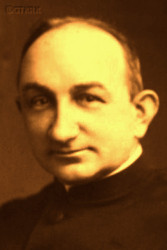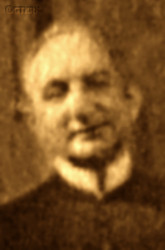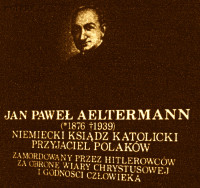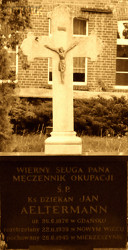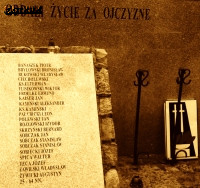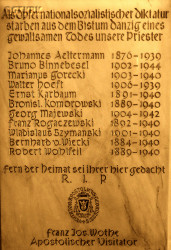Roman Catholic
St Sigismund parish
05-507 Słomczyn
85 Wiślana Str.
Konstancin deanery
Warsaw archdiocese, Poland
full list:
displayClick to display full list

searchClick to search full list by categories
wyświetlKliknij by wyświetlić pełną listę po polsku

szukajKliknij by przeszukać listę wg kategorii po polsku

Martyrology of the clergy — Poland
XX century (1914 – 1989)
personal data
religious status
Servant of God
surname
AELTERMANN
forename(s)
John Paul (pl. Jan Paweł)
forename(s)
versions/aliases
Johannes Paul
function
diocesan priest
creed
Latin (Roman Catholic) Church RCmore on
en.wikipedia.org
[access: 2014.09.21]
diocese / province
Gdańsk diocesemore on
en.wikipedia.org
[access: 2017.01.21]
Apostolic Administration of Free City of Gdańskmore on
en.wikipedia.org
[access: 2017.01.21]
Culm (Chełmno) diocesemore on
pl.wikipedia.org
[access: 2012.11.23]
nationality
German
date and place
of death
22.11.1939

VSH Neu‐Fietztemporary custody
today: Nowy Wiec, Skarszewy gm., Starogard Gdański pov., Pomerania voiv., Poland
more on
en.wikipedia.org
[access: 2022.01.28]
alt. dates and places
of death
19.11.1939, 20.11.1939
details of death
In 1911‐1912 during Prussian rule refused to learn Polish to serve his Polish parishioners. Accused a few reporters of Polish newspapers of slander for articles purporting anti–Polish sentiments and behaviour. As a result 6 journalists were sentenced for prison and fined. As a result, in 1929, when celebrated the 25th anniversary of his priesthood, the Polish newspaper Pl. „Gazeta Morska” (Eng. „Sea Newspaper”) entitled a note about this event „25th Anniversary of the Enemy of Poland”.
In 1933 was publically warning about national–socialism — published a Germ. „Hakenkreuz oder Christenkreuz?” (Eng. „Swastika or Christ's Cross?”) leaflet.
Arrested by the Germans in 1934/1935, for offences against German Chancellor and leader of the German national–socialist worker’s party NSDAP, Adolf Hitler, but a week later released.
Did not yield and in his sermons, among other things, protested against forcing children to give the „party greeting of the National Socialist Party of Germany”. Demanded permission to participate in services for those held in labor camps. As a result, on 09.04.1935, arrested again by the Germ. Polizei der Freien Stadt Danzig (Eng. Police of the Free City of Gdańsk), also known as the Germ. Schutzpolizei (Eng. Protection Police), i.e. Schupo. Accused of „abusing the pulpit for political purposes”, agitation against „various organizations”, and, in particular, an unfavorable stance towards the „Gdańsk labor service”. After a few days released, but immediately after return rearrested again, taken to Gdańsk, placed in police custody, and then after 15 minutes taken to the St Elizabeth Nun's Convent in the Hay Market Square. There released after a further 10 minutes.
Repeatedly harassed by the Germans — supporters of NSDAP. His rectory got pelted with stones.
After German and Russian invasion of Poland in 09.1939 and start of the World War II, after start of German occupation, for a few days went into hiding avoiding arrest.
Finally however arrested by the Germans on 21.11.1939 and taken to VSH Neu‐Fietz temporary custody in Nowy Wiec.
There murdered.
The arrests and genocidal murders — on a farm in the village of Nowy Wiec, c. 9 km north of Skarszewy and 20 km north of Starogard Gdański, belonging to Vladislav Wiecki, whom the Germans had expelled together with his family — were carried out, as part of the German «Intelligenzaktion» (Eng. „Intelligence Action”), i.e. the extermination of the Polish intelligentsia and the leadership classes of Pomerania, by the genocidal unit of the Germ. Volksdeutscher Selbstschutz (Eng. Self‐Defense of Ethnic Germans), i.e. VS, whose members were Germ. Volksdeutsche (Eng. Ethnic Germans), i.e. representatives of the German minority in Poland from Skarszewy and the surrounding area. Supervisory functions were performed by members of the paramilitary, genocidal Germ. Die Schutzstaffel der NSDAP (Eng. NSDAP Protection Unit), i.e. «SS», subordinate to the ruling National Socialist German Workers' Party NSDAP in Germany. Their agents operated the Germ. Volksdeutscher Selbstschutzhaft (Volksdeutscher Selbstschutz custody) VSH Neu–Fietz in Nowy Wiec, which was subordinate to the Inspectorate V VS Preußisch Stargard in Starogard Gdański.
In 09‐10 1939, c. 60 Poles held in the Germ. Polizeihaft Schöneck in Skarszewy, c. 10 km away, and the VSH Gross Klinsch transit camp in Wielki Klincz, c. 23 km away, were transferred to the VSH Neu–Fietz detention center. They were arrested on the basis of the so‐called Germ. Sonderfahndungsliste (Eng. Special Wanted List), i.e. a proscription list of names of „enemies of the Reich”, prepared before the German aggression, or on another proscription list, drawn up ad hoc on the basis of denunciations from local Germ. Volksdeutsche. Held in three basements on the Wiecki farm. Tortured.
In 10‐11.1939, several mass murders were committed there. In particular, on 22.11.1939, 42‐43 people were murdered. The victims were forced to dig holes in which they were then killed.
Before death, had to dig holes, watch the executions of the other victims, and then bury the murdered. Was the last of those murdered that day. And was buried in a separate place, in the local dialect known as a wach, in a hutch, i.e. a part of a barn used for storing grain, hay, straw, or other agricultural products. Representatives of the Germ. kulturnation (Eng. cultural nation) threw a dead cow on top of his body and then buried the pit.
It is estimated that c. 50 more people were murdered there during that time. In total, during World War II, the Germans murdered c. 200‐300 people near the village of Nowy Wiec.
In 1944, facing the approaching German–Russian front and inevitable defeat, as part of the Germ. „Sonderaktion 1005” (Eng. „Special Action 1005”), groups of prisoners, referred to as Germ. „Leichenkommandos” (Eng. „Corpses' Units”) — under the supervision of Germans, members of the genocidal Germ. Sicherheitsdienst des Reichsführers SS (Eng. Security Service of the Reichsführer SS), i.e. «SD» — dug up the bodies of some of the murdered, took them away and, in fact, burned. In 06.1945, during an exhumation, five death pits were discovered, in which the remains of c. 64 people were found. In one of the pits, the bodies of 14 victims were discovered, tied with barbed wire and doused with slaked lime. In another, in an adjacent field, the bodies of 12 women and 1 man were found.
By 1969, the names of 23‐24 victims of the Nowy Wiec murders were identified, including two other Catholic priests: Fr Alphonsus Kwiatkowski and Fr Walter Śpica.
By an extraordinary act of Divine Providence, on 24.05.2008, in Lviv, Marta Anna Wiecka was beatified by the Catholic Church. She was a nun of the Congregation of the Daughters of Charity of Saint Vincent de Paul FdlC, who died in 1904. She was born in Nowy Wiec and related to the Wiecki family, on whose farm the murder took place in 1939. The murdered found an intercessor with their Lord.
cause of death
mass murder
perpetrators
Germans
sites and events
VSH Neu‐FietzClick to display the description, «Intelligenzaktion»Click to display the description, Ribbentrop‐MolotovClick to display the description, Pius XI's encyclicalsClick to display the description
date and place
of birth
26.06.1876Birth certification on:
metryki.genbaza.pl
[access: 2025.09.29]

Gdańsktoday: Gdańsk city pov., Pomerania voiv., Poland
more on
en.wikipedia.org
[access: 2021.07.04]
parents
AELTERMANN Francis
🞲 ?, ? — 🕆 ?, ?

MAY Elisabeth Anne
🞲 ?, ? — 🕆 ?, ?
presbyter (holy orders)
ordination
13.03.1904

Pelplintoday: Pelplin gm., Tczew pov., Pomerania voiv., Poland
more on
en.wikipedia.org
[access: 2021.05.06]
positions held
1925 – 1939
dean — Gdańsk‐countrysidedeanery name
today: Pomerania voiv., Poland RC deanery
06.09.1912 – 1939
parish priest — Mierzeszyntoday: Trąbki Wielkie gm., Gdańsk pov., Pomerania voiv., Poland
more on
en.wikipedia.org
[access: 2022.07.19] ⋄ St Bartholomew the Apostle RC parish ⋄ Gdańsk II / Gdańsk / Gdańsk‐countrysidedeanery names/seats
today: Pomerania voiv., Poland RC deanery — from 15.11.1920, after the ratification on 10.01.1920 of the Treaty of Versailles of 28.06.1919, which ended World War I, in particular after the entry into force of its Articles 100‐108, within the so‐called Free City of Gdańsk; also: c. 1935 councilor of the district assembly of Gdańsk Wyżyny
1912
vicar — Ugoszcztoday: Studzienice gm., Bytów pov., Pomerania voiv., Poland
more on
en.wikipedia.org
[access: 2022.01.28] ⋄ St Mary Magdalene RC parish ⋄ Bytówtoday: Bytów gm., Bytów pov., Pomerania voiv., Poland
more on
en.wikipedia.org
[access: 2022.06.29] RC deanery
1912
vicar — Lęborktoday: Lębork urban gm., Lębork pov., Pomerania voiv., Poland
more on
en.wikipedia.org
[access: 2022.01.28] ⋄ St James the Apostle RC parish ⋄ Lęborktoday: Lębork urban gm., Lębork pov., Pomerania voiv., Poland
more on
en.wikipedia.org
[access: 2022.01.28] RC deanery
1911
vicar — Jeleńcztoday: Kęsowo gm., Tuchola pov., Kuyavia‐Pomerania voiv., Poland
more on
en.wikipedia.org
[access: 2022.02.24] ⋄ St Adalbert the Bishop and Martyr RC parish ⋄ Tucholatoday: Tuchola gm., Tuchola pov., Kuyavia‐Pomerania voiv., Poland
more on
en.wikipedia.org
[access: 2021.09.02] RC deanery
1910 – 1911
vicar — Starogard Gdańskitoday: Starogard Gdański gm., Starogard Gdański pov., Pomerania voiv., Poland
more on
en.wikipedia.org
[access: 2021.06.07] ⋄ St Matthew the Apostle RC parish ⋄ Starogard Gdańskitoday: Starogard Gdański gm., Starogard Gdański pov., Pomerania voiv., Poland
more on
en.wikipedia.org
[access: 2021.06.07] RC deanery
1909 – 1910
vicar — Grucznotoday: Świecie gm., Świecie pov., Kuyavia‐Pomerania voiv., Poland
more on
en.wikipedia.org
[access: 2022.02.24] ⋄ St John the Baptist RC parish ⋄ Świecietoday: Świecie gm., Świecie pov., Kuyavia‐Pomerania voiv., Poland
more on
en.wikipedia.org
[access: 2021.09.02] RC deanery
1909
vicar — Nieżywięćtoday: Bobrowo gm., Brodnica pov., Kuyavia‐Pomerania voiv., Poland
more on
en.wikipedia.org
[access: 2021.09.02] ⋄ St John the Baptist RC parish ⋄ Wąbrzeźnotoday: Wąbrzeźno urban gm., Wąbrzeźno pov., Kuyavia‐Pomerania voiv., Poland
more on
en.wikipedia.org
[access: 2021.09.02] RC deanery
1908 – 1909
vicar — Wałdowotoday: Sępólno Krajeńskie gm., Sępólno Krajeńskie pov., Kuyavia‐Pomerania voiv., Poland
more on
en.wikipedia.org
[access: 2021.09.02] ⋄ St Matthew the Apostle and the Evangelist RC parish ⋄ Tucholatoday: Tuchola gm., Tuchola pov., Kuyavia‐Pomerania voiv., Poland
more on
en.wikipedia.org
[access: 2021.09.02] RC deanery
1904 – 1908
vicar — Tucholatoday: Tuchola gm., Tuchola pov., Kuyavia‐Pomerania voiv., Poland
more on
en.wikipedia.org
[access: 2021.09.02] ⋄ St Bartholomew the Apostle RC parish (main parish) ⋄ Tucholatoday: Tuchola gm., Tuchola pov., Kuyavia‐Pomerania voiv., Poland
more on
en.wikipedia.org
[access: 2021.09.02] RC deanery
vicar — Sulęczynotoday: Sulęczyno gm., Kartuzy pov., Pomerania voiv., Poland
more on
en.wikipedia.org
[access: 2021.09.02] ⋄ Holy Trinity RC parish ⋄ Mirachowotoday: Kartuzy gm., Kartuzy pov., Pomerania voiv., Poland
more on
en.wikipedia.org
[access: 2020.11.27] RC deanery
vicar — Frydlądalso: Frydląd Pomorski
today: Debrzno, Debrzno gm., Człuchów pov., Pomerania voiv., Poland
more on
en.wikipedia.org
[access: 2022.01.28] ⋄ Assumption of the Blessed Virgin Mary RC parish ⋄ Człuchówtoday: Człuchów gm., Człuchów pov., Pomerania voiv., Poland
more on
en.wikipedia.org
[access: 2021.09.02] RC deanery
1899 – 1904
student — Pelplintoday: Pelplin gm., Tczew pov., Pomerania voiv., Poland
more on
en.wikipedia.org
[access: 2021.05.06] ⋄ philosophy and theology, Theological Seminary
1899
pupil — Chełmnotoday: Chełmno urban gm., Chełmno pov., Kuyavia‐Pomerania voiv., Poland
more on
en.wikipedia.org
[access: 2021.07.25] ⋄ Germ. Königliche Katholische Gymnasium (Eng. Royal Catholic Gymnasium) — studies completed with the maturity diploma (i.e. matura)
till 1899
pupil — Gdańsktoday: Gdańsk city pov., Pomerania voiv., Poland
more on
en.wikipedia.org
[access: 2021.07.04] ⋄ Germ. Königliche Gymnasium (Eng. Royal Gymnasium)
others related
in death
BINNEBESELClick to display biography Bruno, GÓRECKIClick to display biography Marian, HOEFTClick to display biography Walter Joseph, KOMOROWSKIClick to display biography Bronislav Boleslav, MAJEWSKIClick to display biography George Alphonse, ROGACZEWSKIClick to display biography Francis Xavier, SZYMAŃSKIClick to display biography Vladislav, WIECKIClick to display biography Bernard Anthony, WOHLFEILClick to display biography Robert, KWIATKOWSKIClick to display biography Alphonse Louis, ŚPICAClick to display biography Walter John
sites and events
descriptions
VSH Neu‐Fietz: German Germ. Volksdeutscher Selbstschutzhaft (Eng. Volksdeutscher Selbstschutz custody) VSH for the inhabitants of the Skarszewy county and vicinity established in 09/10.1939 by Germans, members of the genocidal paramilitary Germ. Volksdeutscher Selbstschutz formation — the decision to create Selbstschutz in the Polish lands occupied by German troops was made in Berlin on 08‐10.09.1939 at a conference headed by Reichsführer‐SS Heinrich Himmler (the formal order bears the date 20.09.1939), and the chaotically formed units were directly subordinated to the officers of the genocidal«SS» organization — on the farm in Nowy Wiec village, the property of Vladislav Wiecki, whom the Germans evicted with his family and displaced. In 09‐10.1939, c. 60 Poles held in Skarszewy and the transit camp in Wielki Klincz were transported there. They were kept in three basements. On 19‐22.11.1939 the Germans murdered there 68 Polish citizens, in several executions (according to other sources 42‐43). Before being shot, the victims had to dig their own graves. At the same time, in 10‐11.1939, the Germans murdered an additional c. 50 Poles. After the end of hostilities in 1945, 5 mass graves were unearthed. In one, the bodies of 14 victims were found tied with barbed wire, covered with grass and poured with lime. In another, the bodies of 12 women and 1 man were found. In 1944, the Germans dug up the bodies from the remaining graves, took them to an unknown place and burned them. (more on: pl.wikipedia.orgClick to attempt to display webpage
[access: 2013.01.06])
«Intelligenzaktion»: German: «Intelligenzaktion» (English: „Intelligence Action”) — a German program of extermination of the Polish elite, mainly the intelligentsia and leadership layers, carried out from the beginning of the occupation in w 09.1939 to 04.1940, mainly in territories directly annexed to Germany, but also in the so‐called Germ. Generalgouvernement (Eng. General Governorate), where it was called «AB‐aktion». In the first phase, immediately after the beginning of the German occupation, during military operations carried out by the Germ. Wehrmacht (Eng. Armed Forces) and the genocidal units of the Germ. Einsatzgruppen (Eng. Operational Groups) of the Germ. Sicherheitspolizei (Eng. Security Police), i.e. SiPo, and Germ. Sicherheitsdienst des Reichsführers SS (Eng. Security Service of the Reichsführer SS), i.e. SD, organized by the Germ. Reichssicherheitshauptamt (Eng. Reich Main Security Office), i.e. RSHA, which followed the troops, carried out under the Germ. Unternehmen „Tannenberg” (Eng. Operation „Tannenberg”) — based on the so‐called Germ. Sonderfahndungsliste (Eng. Special Wanted Lists), i.e. proscription lists of Poles considered particularly dangerous to the Third Reich, prepared by the Zentralstelle II/P (Polen) unit of the German RSHA. Later, implemented by the German civilian occupation authorities and the genocidal unit of the Germ. Volksdeutscher Selbstschutz (Eng. Ethnic Germans Self‐Defense), whose members were Germ. Volksdeutsche (Eng. Ethnic Germans), i.e. representatives of the German minority in Poland. According to various sources, these lists, at the beginning of 09.1939, could have contained the details of 61,000—88,000 „dangerous” Poles — although these figures cannot be confirmed. In total, during this genocide, c. 50,000 teachers, Catholic priests, representatives of the landed gentry, freelancers, social and political activists, and retired military personnel were systematically and methodically murdered. Another 50,000 were sent to concentration camps, where only a negligible percentage survived. (more on: en.wikipedia.orgClick to attempt to display webpage
[access: 2014.10.04])
Ribbentrop‐Molotov: Genocidal Russian‐German alliance pact between Russian leader Joseph Stalin and German leader Adolf Hitler signed on 23.08.1939 in Moscow by respective foreign ministers, Mr. Vyacheslav Molotov for Russia and Joachim von Ribbentrop for Germany. The pact sanctioned and was the direct cause of joint Russian and German invasion of Poland and the outbreak of the World War II in 09.1939. In a political sense, the pact was an attempt to restore the status quo ante before 1914, with one exception, namely the „commercial” exchange of the so‐called „Kingdom of Poland”, which in 1914 was part of the Russian Empire, fore Eastern Galicia (today's western Ukraine), in 1914 belonging to the Austro‐Hungarian Empire. Galicia, including Lviv, was to be taken over by the Russians, the „Kingdom of Poland” — under the name of the General Governorate — Germany. The resultant „war was one of the greatest calamities and dramas of humanity in history, for two atheistic and anti‐Christian ideologies — national and international socialism — rejected God and His fifth Decalogue commandment: Thou shall not kill!” (Abp Stanislav Gądecki, 01.09.2019). The decisions taken — backed up by the betrayal of the formal allies of Poland, France and Germany, which on 12.09.1939, at a joint conference in Abbeville, decided not to provide aid to attacked Poland and not to take military action against Germany (a clear breach of treaty obligations with Poland) — were on 28.09.1939 slightly altered and made more precise when a treaty on „German‐Russian boundaries and friendship” was agreed by the same murderous signatories. One of its findings was establishment of spheres of influence in Central and Eastern Europe and in consequence IV partition of Poland. In one of its secret annexes agreed, that: „the Signatories will not tolerate on its respective territories any Polish propaganda that affects the territory of the other Side. On their respective territories they will suppress all such propaganda and inform each other of the measures taken to accomplish it”. The agreements resulted in a series of meeting between two genocidal organization representing both sides — German Gestapo and Russian NKVD when coordination of efforts to exterminate Polish intelligentsia and Polish leading classes (in Germany called «Intelligenzaktion», in Russia took the form of Katyń massacres) where discussed. Resulted in deaths of hundreds of thousands of Polish intelligentsia, including thousands of priests presented here, and tens of millions of ordinary people,. The results of this Russian‐German pact lasted till 1989 and are still in evidence even today. (more on: en.wikipedia.orgClick to attempt to display webpage
[access: 2015.09.30])
Pius XI's encyclicals: Facing the creation of two totalitarian systems in Europe, which seemed to compete with each other, though there were more similarities than contradictions between them, Pope Pius XI issued in 03.1937 (within 5 days) two encyclicals. In the „Mit brennender Sorge” (Eng. „With Burning Concern”) published on 14.03.1938, condemned the national socialism prevailing in Germany. The Pope wrote: „Whoever, following the old Germanic‐pre‐Christian beliefs, puts various impersonal fate in the place of a personal God, denies the wisdom of God and Providence […], whoever exalts earthly values: race or nation, or state, or state system, representatives of state power or other fundamental values of human society, […] and makes them the highest standard of all values, including religious ones, and idolizes them, this one […] is far from true faith in God and from a worldview corresponding to such faith”. On 19.03.1937, published „Divini Redemptoris” (Eng. „Divine Redeemer”), in which criticized Russian communism, dialectical materialism and the class struggle theory. The Pope wrote: „Communism deprives man of freedom, and therefore the spiritual basis of all life norms. It deprives the human person of all his dignity and any moral support with which he could resist the onslaught of blind passions […] This is the new gospel that Bolshevik and godless communism preaches as a message of salvation and redemption of humanity”… Pius XI demanded that the established human law be subjected to the natural law of God , recommended the implementation of the ideal of a Christian state and society, and called on Catholics to resist. Two years later, National Socialist Germany and Communist Russia came together and started World War II. (more on: www.vatican.vaClick to attempt to display webpage
[access: 2023.05.28], www.vatican.vaClick to attempt to display webpage
[access: 2023.05.28])
sources
personal:
kronikatrabkiwielkie.plClick to attempt to display webpage
[access: 2013.01.06], www.niedziela.plClick to attempt to display webpage
[access: 2013.01.06], gdansk.gedanopedia.plClick to attempt to display webpage
[access: 2025.11.05], metryki.genbaza.plClick to attempt to display webpage
[access: 2025.09.29], pl.wikipedia.orgClick to attempt to display webpage
[access: 2013.01.06], powiat-gdanski.plClick to attempt to display webpage, www.przywidz.orgClick to attempt to display webpage
[access: 2014.10.31], spmierzeszyn.edupage.orgClick to attempt to display webpage
[access: 2014.10.31], apcz.umk.plClick to attempt to display webpage
[access: 2025.11.05], www.facebook.comClick to attempt to display webpage
bibliographical:
„Biographical dictionary of priests of the Chełmno diocese ordained in the years 1821‐1920”, Henry Mross, Pelplin, 1995
original images:
kronikatrabkiwielkie.plClick to attempt to display webpage
[access: 2013.01.06], www.parafia.i3k.plClick to attempt to display webpage
[access: 2015.04.18], spmierzeszyn.edupage.orgClick to attempt to display webpage
[access: 2014.10.31], www.przywidz.orgClick to attempt to display webpage
[access: 2014.10.31], de.wikipedia.orgClick to attempt to display webpage
[access: 2015.04.18]
LETTER to CUSTODIAN/ADMINISTRATOR
If you have an Email client on your communicator/computer — such as Mozilla Thunderbird, Windows Mail or Microsoft Outlook, described at WikipediaPatrz:
en.wikipedia.org, among others — try the link below, please:
LETTER to CUSTODIAN/ADMINISTRATORClick and try to call your own Email client
If however you do not run such a client or the above link is not active please send an email to the Custodian/Administrator using your account — in your customary email/correspondence engine — at the following address:

giving the following as the subject:
MARTYROLOGY: AELTERMANN John Paul
To return to the biography press below:
 Click to return to biography
Click to return to biography








